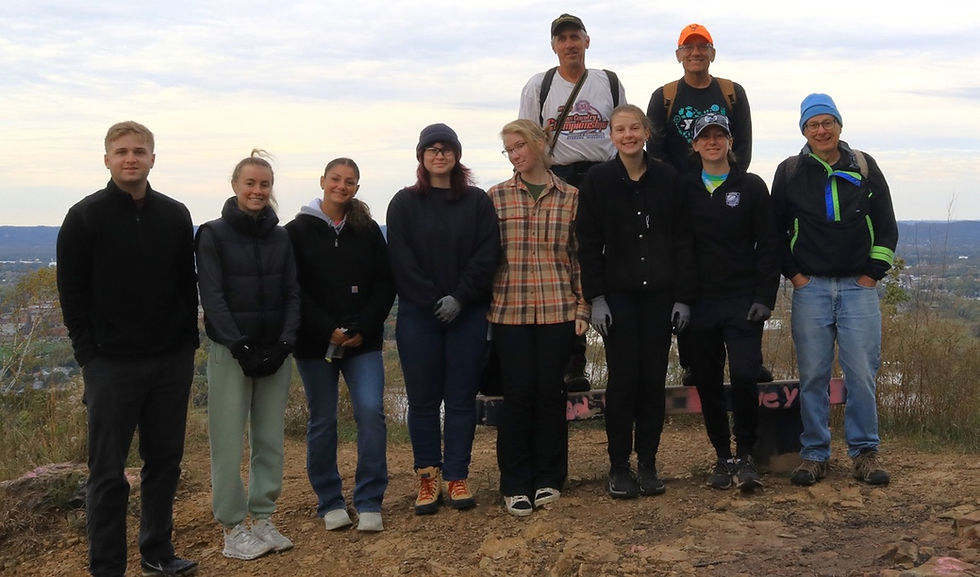Trees, Trees, and More Trees
- jonathanrigden
- Mar 20, 2024
- 3 min read
In 2010 a seven acre field on the corner of F and FA that previously grew corn was planted with a few thousand trees. This is the corner up Bliss Road, past the Alpine Inn where you turn left to go to Upper Hixon or the weather station. The field is part of a 22 acre parcel that was acquired in 2007 as part of the La Crosse Blufflands Protection Program with the coordinated efforts of the City, the Mississippi Valley Conservancy, and the Knowles Nelson Stewardship Fund of Wisconsin. A variety of trees were planted by the Conservancy including red, white, bur, and swamp white oaks as well as some shag bark hickory. They were initially protected with tubes, but many of these toppled over from the wind over the ensuing years and were removed leaving the trees unprotected. In this unprotected state the deer had a feast, browsing the trees each year and preventing most of them from growing. This resulted in many small, multi-stemmed trees that looked more like little bushes.
In about 2017, Friends of the Blufflands began protecting these trees with cages about two feet in diameter cut from rolls of 6 foot fencing. A small number of new oaks and cherry trees were planted and caged to fill in some of the gaps. With this protection, the trees thrived and many quickly grew out of the cages. At this point, the cages were moved to other small trees needing protection while the trunks of the uncaged trees were protected from deer rub with tubes or small 3 foot cages. Along the way, the trees were pruned as needed to create a main trunk or leader. This has been a lot of work but we now have a nice stand of oaks, hickories, a few cherry, and some volunteer walnut growing well. There is even one white pine that grew as a volunteer that we decided to keep!
One person who deserves a lot of credit for this work is Fred Skemp. Well known for his feats over the years in endurance sports including running, paddling, skiing, and biking, Fred is cementing a reputation that is just as impressive with his work in Hixon Forest and the surrounding bluffs. He has been active with forest restoration at this location and many others as well as being dedicated for many years creating and maintaining the trails we all love. Despite an age when many of us would have given up this type of work, Fred, like the “Energizer Bunny”, just keeps going and going! What an inspiration he has been for the rest of us!
Fred Hard at Work
As can be seen in the photo, many of the trees have already reached an impressive height! The eventual goal is to have a mix of predominately oak trees forming a closed canopy forest that will shade out the thick grasses, including reed canary grass, that are presently growing. To reach this goal, Friends has been fortunate to have the guidance of Greg Edge, Forest Ecologist/Silviculturist for the DNR, who has generously donated his time over the years to help keep us on track. A closed canopy forest will take many more years to form but over time the trees will merge their canopies to become a true forest. During this time a lot of self-thinning will occur as the “winners” overtake and crowd out their neighbors. Eventually, we will likely do some thinning ourselves and with time we believe it will look less and less like a plantation planted in rows. In the meantime, we will continue to move the cages to smaller trees still needing protection, protect the trunks of the trees, and do some selective pruning.
An Interpretive Sign on the Site
As many know, oaks are having a difficult time regenerating in our forests, including Hixon Forest and the surrounding bluffs, in large part due to the high deer population. We hope that this little patch of oaks and other trees will thrive for many years providing a high quality forest that will benefit many plants and animals. Oaks are known to be especially good habitat for many insects which in turn feed many birds and other animals as so eloquently described by Douglas Tallamy in his book, The Nature of Oaks. He says, “With our hearts and minds focused on stewardship of the only planet we have, the best way to engage in a hopeful future is to plant oaks!”







Once again, "Skipper" is out, standing in his field!